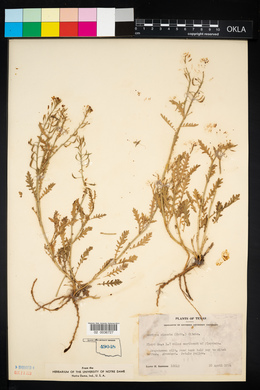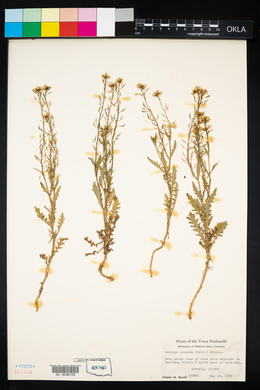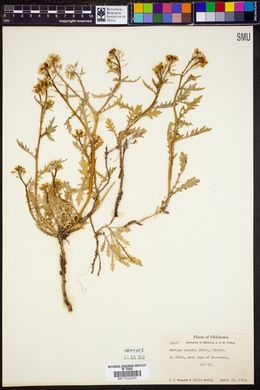|
|
|
|
Family: Brassicaceae
bluntleaf yellowcress, more...spreading yellowcress, blunt-leaf yellowcress
[Nasturtium sinuatum Nutt., moreNasturtium sinuatum var. columbiae Suksd. ex B.L. Rob., Radicula sinuata (Nutt.) Greene] |
Perennials; (rhizomatous or with creeping roots); sparsely to moderately pubescent, (trichomes hemispherical, vesicular). Stems (many to few from base), decumbent or prostrate, branched distally, 1-4.2(-5) dm, (pubescent proximally). Basal leaves not rosulate; blade margins pinnatifid. Cauline leaves sessile; blade oblong to oblanceolate or lanceolate (lateral lobes oblong or ovate), (1.5-)2.5-6.5(-9) cm × 5-18(-25) mm, base usually auriculate, rarely proximalmost not auriculate, margins pinnatifid to deeply sinuate, or (lateral lobes) dentate to sinuate or entire, (surfaces pubescent abaxially with vesicular trichomes on veins, glabrous adaxially). Racemes considerably elongated. Fruiting pedicels divaricate-ascending to horizontal, sigmoid or recurved, 4-12(-14.5) mm. Flowers: sepals ascending, oblong, 2.2-3.7(-4.5) × 1-1.8 mm; petals yellow, oblanceolate to spatulate, (2.7-)3.2-5.3(-6) × 1.5-2.5 mm; median filaments 3-5.5 mm; anthers narrowly oblong, 1.2-1.7 mm. Fruits siliques, curved, oblong to lanceolate or linear, (4-)5-12(-16) × (1-)1.5-2.5 mm; valves glabrous or pubescent; ovules (30-)50-82(-98) per ovary; style (0.8-)1-2.5(-3.5) mm. Seeds biseriate, yellow-brown, angled, cordiform, 0.7-1 mm (0.5-0.6 mm diam.), colliculate. 2n = 16. Flowering Apr-Aug. Shores of ponds and lakes, sandy banks, stream banks, fields, wet depressions, gravel banks, ditches, moist grounds; 0-2600 m; Alta., B.C., Ont., Sask.; Ariz., Ark., Calif., Colo., Idaho, Ill., Iowa, Kans., Ky., La., Minn., Mo., Mont., Nebr., Nev., N.Mex., N.Dak., Okla., Oreg., S.Dak., Tenn., Tex., Utah, Wash., Wis., Wyo. Annuals or, rarely, perennials; (short-lived, terrestrial or of wet habitat, not submerged); glabrous or hirsute, (trichomes cylindrical). Stems (few to several from base), usually ascending, decumbent, or prostrate, rarely erect, branched distally, 1-4.2(-5) dm, (hirsute proximally). Basal leaves not rosulate; blade margins pinnatifid. Cauline leaves shortly petiolate or sessile; blade oblong or oblanceolate to obovate, (terminal lobe oblong), (2-)3.5-10(-12) cm × (5-)10-30(-37) mm, (lateral lobe smaller than terminal), base usually auriculate, rarely amplexicaul, margins: proximal pinnatifid or sinuate, distal dentate or entire, (surfaces sparsely pubescent). Racemes elongated. Fruiting pedicels divaricate-ascending to horizontal, straight or recurved, (1.2-) 1.7-5(-8) mm. Flowers: sepals erect, oblong, 0.8-1.8 × 0.5-1 mm; petals (erect), yellow, oblanceolate to spatulate, 0.5-1.8 × 0.2-1 mm; median filaments 0.9-1.3 mm; anthers ovate, 0.3-0.5 mm. Fruits silicles or siliques, curved, ovoid to pyriform, 2-8(-8.8) × (0.5-) 1-2.5 mm; valves glabrous; ovules (20-)30-80 per ovary; style 0.3-1 mm. Seeds biseriate, brown, cordiform, 0.5-0.7 mm, colliculate. 2n = 16. Flowering May-Sep. Muddy shores of lakes and ponds, stream beds and banks, edges of cultivated fields, wet roadside, meadows, seepage areas, ditches, creeks, gravel bars; 100-3500 m; Alta., B.C., Sask.; Ariz., Ark., Calif., Colo., Idaho, Ill., Kans., Mich., Minn., Mo., Mont., Nebr., Nev., N.Mex., N.Dak., Oreg., S.Dak., Tex., Utah, Wash., Wyo.; Mexico (Coahuila). Plant: Perennial; stem prostrate to ascending, 1-4(5) dm; hairs sparse to dense, sac-like Leaves: basal and lower cauline short-petioled, oblanceolate, deeply dentate to deeply pinnately lobed, rarely 1-pinnate; middle, upper sessile, ± clasping stem, 3-6(8) cm, with sac-like hairs on midribs INFLORESCENCE: racemes, terminal and lateral Flowers: bisexual; sepals 4, free, not persistent in fruit; petals 3.5-5.5 mm, oblanceolate to spoon-shaped, yellow; stamens generally (2,4)6, generally 4 long, 2 short; ovary 1, superior, chambers generally 2, septum membranous, connecting 2 parietal placentas, style 1, stigma simple or 2-lobed Fruit: capsule with 2 deciduous valves, 5-13 mm, narrowly oblong, upcurved; pedicel ascending to recurved, 5-11(15) mm, S-shaped or not; style 1-2 mm; Seed 0-200, (1)2 rows per chamber, dense, 0.7-1 mm, ± widely reniform, angled; wing 0; embryonic root at edges of both cotyledons Misc: Lake shores, playas, wet depressions; 900-1900 m.; May-Sep Plant: Annual, rarely ± short-lived perennial herb, generally ± glabrous; stem 1-5 dm, branched, often from near base; hairs often below, ± sparse Leaves: basal ± entire to deeply pinnately lobed, rarely partly ± 1-pinnate, generally petioled; cauline 0 or 4-8 cm, 5-15 mm wide, oblong, obovate, or oblanceolate, clasping stem, entire to ± pinnately lobed INFLORESCENCE: racemes, terminal and lateral Flowers: small, bisexual; sepals 4, free; petals (0)4, free, petals ascending, oblong to ± tongue-shaped, yellow; stamens generally (2,4)6, generally 4 long, 2 short; ovary 1, superior, chambers generally 2, septum membranous, connecting 2 parietal placentas, style 1, stigma simple or 2-lobed Fruit: capsules with 2 deciduous valves, straight to upcurved, generally narrowed near middle, smooth, glabrous; pedicel 2-5 mm; style 0.5-1 mm; Seeds 10-200, (1)2 rows per chamber, dense, generally plump, ± reniform, finely papillate; wing 0; embryonic root at edges of both cotyledons Misc: Wet sites; < 2300 m. |














































